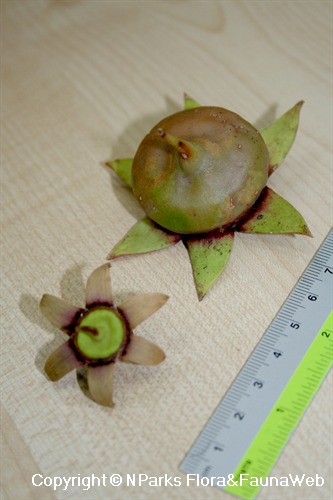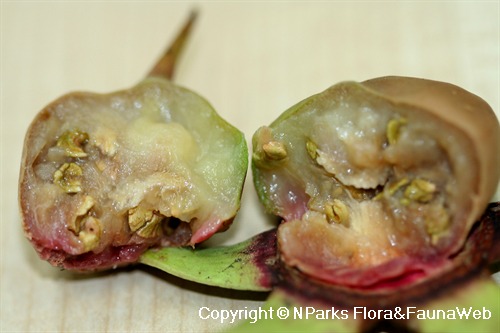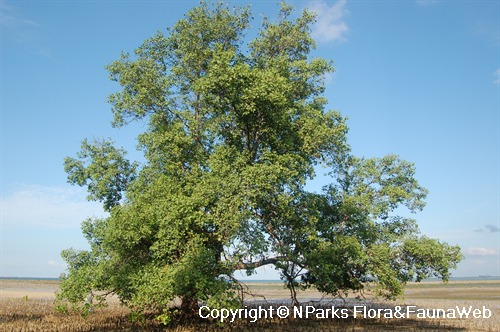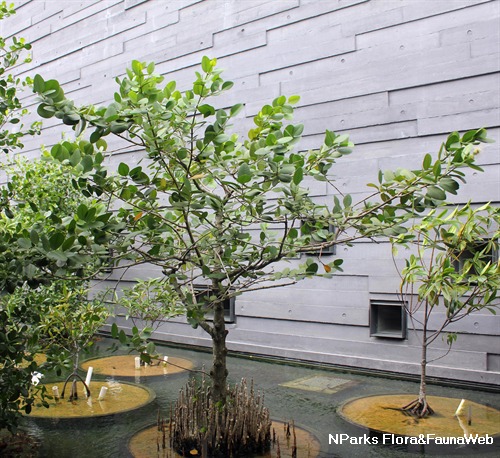-(27).jpg)
Back
Sonneratia caseolaris (L.) Engl.
| Family Name: | Lythraceae |
| Synonyms: | Sonneratia acida, Ammania caseolaris |
| Common Name: | Crabapple Mangrove, Mangrove Apple, Firefly Mangrove, Berembang |
Name
Classifications and Characteristics
| Plant Division | Angiosperms (Flowering Seed Plants) (Dicotyledon) |
|---|---|
| Plant Growth Form | Tree (Medium (16m-30m)), Aquatic & Hydrophyte (Waterside / Marginal) |
| Lifespan (in Singapore) | Perennial |
| Mode of Nutrition | Autotrophic |
| Plant Shape | Irregular, Weeping / Pendulous, Open |
| Maximum Height | 5 m to 20 m |
Biogeography
| Native Distribution | From the west coast of India to southern China, tropical Southeast Asia, through the western islands of the Pacific Ocean to New Guinea, and northern Australia |
|---|---|
| Native Habitat | Shoreline (Mangrove Forest) |
| Preferred Climate Zone | Tropical |
| Local Conservation Status | Native to Singapore (Critically Endangered (CR)) |
Description and Ethnobotany
| Growth Form | It is a tree usually up to 15 m tall, occasionally reaching 20 m. |
|---|---|
| Crown | Its branches droop so the crown resembles that of a weeping willow (Salix species). |
| Trunk | Brown to grey and slightly fissured on trunk, Young bark on stems and branches smooth waxy brown. |
| Roots | It has underground roots as well as up to 1.5 m-tall upright, breathing roots (pneumatophores) at its base. |
| Foliage | Its opposite, shortly-stalked leaves possess leathery leaf blades that vary from oval to drop-shaped. The deep green leaf blades are 4.5–13 by 1.5–7 cm. |
| Flowers | Its flowering shoots bear dark red-petalled flowers that are 1.5 cm wide, with numerous prominent pinkish-white stamens, filamentous and powderpuff-like when fully open. The flowering shoots are found at leaf angles, or develop at the ends of leafy branches. The flowers open at dusk and last only for 1 night, scented like butter or sour milk, nectar-rich, which attracts and are pollinated by bats. During dawn, it may be be visited by bees and nectivorous birds. |
| Fruit | Its green fruits are round, leathery berries that are up to 7.5 cm wide. They are seated on a flattened, cup-like structure formed by the persistent sepals. Its buoyant, water-dispersed seeds are irregularly shaped, up to 7 mm long, and embedded in fruit’s fleshy pulp. |
| Habitat | Usually found in deep muddy soils at brackish backwaters of mangroves and upper reaches of tidal rivers with slow-moving water. One of the first mangrove species to colonize riverbank and mudflats in new habitats. |
| Associated Fauna | Host plant for Pteroptyx tener beetle (Malaysian Firefly) which flocks to tree and flashes synchronously at night. Tree's exact relationship with firefly unknown, but Pteroptyx tener is thought to be attracted to the open crown (where the males' mating flashes can be easily seen), and adults apparently feed on either the tree's sap, young leaves, flower nectar or scale insects specific to the tree, while the amphibious carnivorous larvae nest in the undergrowth vegetation below tree, feeding on aquatic snails (Cyclotropis carinata) and nematodes. Tree's leaves form main source of food for Nasalis larvatus (Proboscis Monkey). Its flowers are visited by fruit bats, honeybirds, and large night-moths. It is the preferred local food plant for caterpillars of the moths Indarbela quadrinotata, Lymantria lepcha, Suana concolor, Trabala irrorata, and Trabala vishnou. |
| Cultivation | It is propagated by seed. |
| Etymology | Latin Sonneratia, after Pierre Sonnerat (1749–1841), French botanist and explorer; Latin caseolaris, small cheese, referring to this species’ distinctive rounded shape of the fruit |
| Ethnobotanical Uses | Edible Plant Parts : Edible Fruits, Edible Leaves, Edible Flowers Food (Fruit or Vegetable): Young leaves eaten raw or cooked. Sour young fruits used to make vinegar, and as flavouring in chutneys and curries. Mature fruits eaten raw or cooked, said to taste like cheese. Fruit pectin extracted to make clear jelly. (Herb or Spice) Medicinal: Varrious folk remedies. Fermented fruit juice used to arrest haemorrhage. Juice from flowers treats blood in urine. Wall of old fruit given as vermifuge against intestinal worms. Juice of semi-ripe fruit used to treat coughs. Poultices made from fruits treat sprains and swellings. Pounded leaves used to treat smallpox. Timber & Products: Pest-resistant heavy timber used in construction, boat-building, for bridges, posts and poles. But wood tends to corrode metal due to naturally high mineral content. Pneumatophore roots dried and used as corks and fishing-floats. |
Landscaping Features
| Landscaping | The tree is rather attractive with a crown of drooping branches that resemble the crown of a weeping willow. Its tolerance for waterlogged conditions, both freshwater or brackish means that it can also be grown along tidal river banks, ponds, or reservoirs like a weeping willow, so is a good native-plant substitute for the latter. It has attractive red flowers that open at dusk, giving off a smell of sour milk that lasts for one night. |
|---|---|
| Desirable Plant Features | Ornamental Flowers, Fragrant (Flowers) (Day, Night, Dawn / Dusk), Ornamental Form |
| Landscape Uses | Coastal, Riverine, Beachfront / Shoreline, Pond / Lake / River, Marsh / Bog |
| Thematic Landscaping | Water Garden, Naturalistic Garden |
| Plant & Rootzone Preference or Tolerance Remarks | Plant is native to brackish backwaters of mangroves and upper sections of tidal rivers. |
Fauna, Pollination and Dispersal
| Fauna Pollination Dispersal Associated Fauna | Bird-Attracting (Flowers), Caterpillar Moth Food Plant (Leaves) |
|---|---|
| Pollination Method(s) | Biotic (Fauna) (Vertebrates (Bat), Associated with: Pollinators: Dawn Bat (Eonycteris spelaea), Common Long-tailed Bat (Macroglossus minimus), Lesser Short-nosed Fruit Bat (Cynopterus brachyotis) -- same pollinators for durians, bananas and papayas., Insects (Butterfly, Moth), Insects (Bee)) |
| Seed or Spore Dispersal | Abiotic |
Plant Care and Propagation
| Light Preference | Full Sun |
|---|---|
| Water Preference | Lots of Water |
| Plant Growth Rate | Fast |
| Rootzone Tolerance | Waterlogged Soils (Drains Site, Does not Drain Site), Saline Soils / Salt Spray, Fertile Loamy Soils |
| Maintenance Requirements | Low |
| Propagation Method | Seed, Stem Cutting |
Foliar
| Foliage Retention | Evergreen |
|---|---|
| Mature Foliage Colour(s) | Green |
| Mature Foliage Texture(s) | Leathery |
| Foliar Modification | Salt Excreting |
| Foliar Type | Simple / Unifoliate |
| Foliar Arrangement Along Stem | Opposite |
| Foliar Attachment to Stem | Petiolate |
| Foliar Shape(s) | Non-Palm Foliage (Obovate, Elliptical, Oval) |
| Foliar Venation | Pinnate / Net |
| Foliar Margin | Entire |
| Foliar Apex - Tip | Acute |
| Foliar Base | Acute |
| Typical Foliar Area | Notophyll ( 20.25cm2 - 45 cm2 ) |
| Leaf Area Index (LAI) for Green Plot Ratio | 3.0 (Tree - Intermediate Canopy) |
Non - Foliar and Storage
| Branch Angle (wrt vertical) | Horizontal |
|---|---|
| Trunk Type (Non Palm) | Woody |
| Bark Colour(s) | Gray |
| Mature Bark Texture | Cracked, Plated |
| Stem Type & Modification | Woody |
| Root Type | Aboveground (Pneumatophore / Pencil Root), Underground |
| Mature Bark Texture Remarks | Young bark is waxy and smooth. |
Floral (Angiosperm)
| Flower & Plant Sexuality | Bisexual Flowers |
| Flower Colour(s) | Pink, Red, White |
|---|---|
| Flower Grouping | Cluster / Inflorescence |
| Flower Location | Axillary, Terminal |
| Flowering Period | Free-Flowering |
| Flowering Opening Time | Night (dusk to dawn) |
| Flower Lifespan on Plant | 1 Night |
| Flowering Habit | Polycarpic |
Fruit, Seed and Spore
| Mature Fruit Colour(s) | Brown, Green |
|---|---|
| Fruit Classification | Simple Fruit |
| Fruit Type | Fleshy Fruit , Berry |
| Seed Description | Irregularly shaped, buoyant. |
| Seed Quantity Per Fruit | Numerous (>20) |
Image Repository
Others
| Master ID | 17791 |
|---|---|
| Species ID | 3343 |
| Flora Disclaimer | The information in this website has been compiled from reliable sources, such as reference works on medicinal plants. It is not a substitute for medical advice or treatment and NParks does not purport to provide any medical advice. Readers should always consult his/her physician before using or consuming a plant for medicinal purposes. |

.jpg)
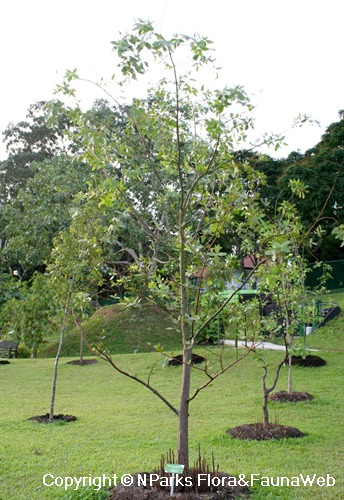
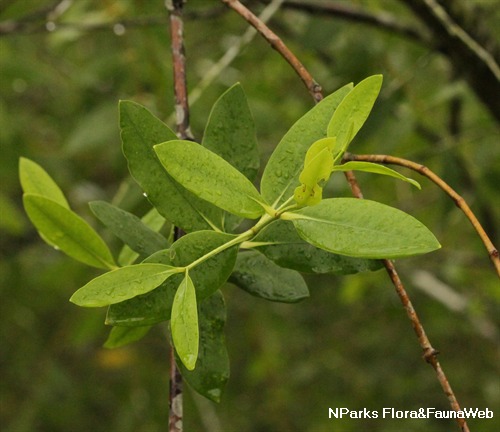
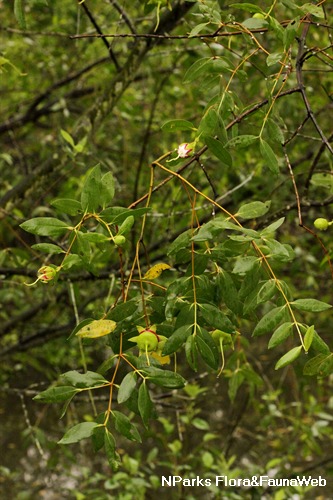
-(20.jpg)

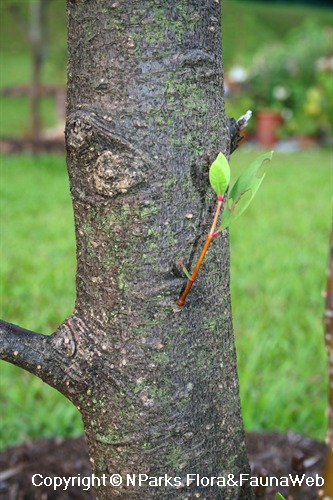

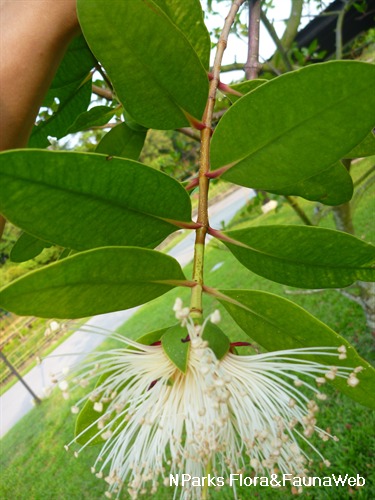
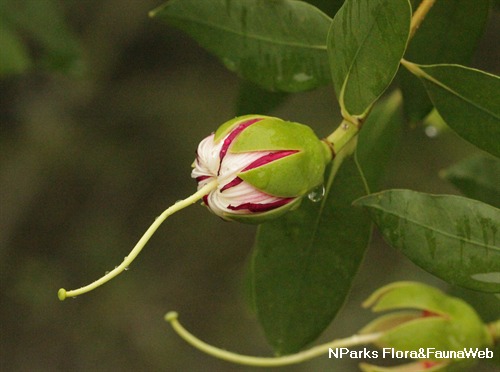
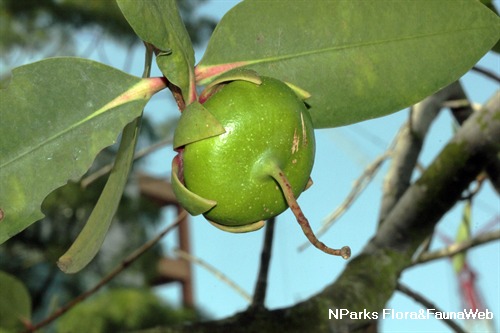
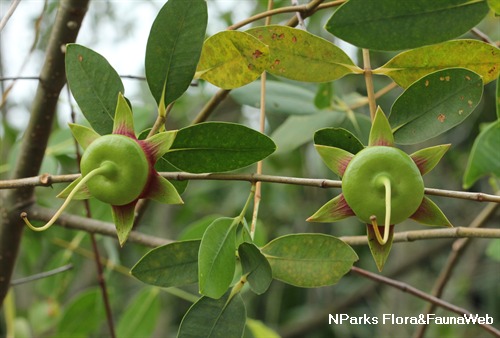
.jpg)
